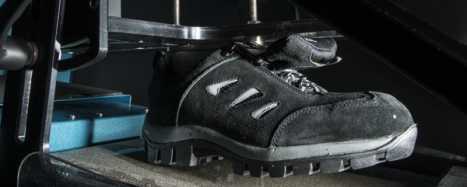The ASTM E303 slip resistance test

The ASTM E303 slip resistance test standard defines the British pendulum tester that is now a national standard for pedestrian floor slip resistance in 49 nations on five continents and has been endorsed by Ceramic Tile Institute of America since 2001. It is the most widely used pedestrian slip resistance test method worldwide. The most common safety standard for a level floor is a minimum Pendulum Test Value (PTV) of 36. The pendulum is the basis of the Sustainable Slip Resistance standard that has been specified by McDonalds Restaurants since 2006. Here is a video demo of the pendulum slip resistance tester.
Pendulum Slip Resistance Tester in action Both hard and soft rubbers are specified for the pendulum, with soft rubber being applied primarily to barefoot situations such as showers, bathroom floors, and swimming pool decks.
This test method covers the procedure for measuring surface frictional properties using the British Pendulum Skid Resistance Tester.2 A method for calibration of the tester is included in the Annex. The British Pendulum Tester is a dynamic pendulum impact-type tester used to measure the energy loss when a rubber slider edge is propelled over a test surface. The tester is suited for laboratory as well as field tests on flat surfaces, and for polish value measurements on curved laboratory specimens from accelerated polishing-wheel tests.
Test results are usually quoted as Pendulum Test Values to avoid the confusion that results when different devices are used to give different values of coefficient of friction. Standards Australia HB 198:2014 gives detailed recommendations of minimum wet Pendulum Test Values for many different situations: e.g. external ramps, 54; external walkways and pedestrian crossings, 45; shopping center food courts, 35; and elevator lobbies above external entry level may be 25 or less. There are also barefoot area recommendations based on pendulum tests with a soft rubber slider. The Australian recommendations, published in 1999 and expanded in 2014, are the world’s most detailed and sophisticated standards for pedestrian wet slip resistance. They have also been used by cruise ship companies and others outside of Australia.
2017-12-26 17:20

